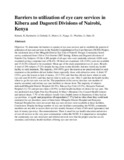| dc.description.abstract | Objective: To determine the barriers to uptake of eye care services and to establish
the pattern of utilization of eye care services in the Nairobi Comprehensive Eye
Care Services (NCES) Project; the catchment area of the Mbagathi District Eye
Unit of Nairobi.
Design: Community based survey conducted from 15th to 31st October 2007
Setting: Kibera and Dagoreti divisions of Nairobi City
Subjects: Of the 4,200 people of all ages who were randomly selected; 4,056
were examined giving a response rate of 96.6%. Of those not examined, 126
(3.0%) were not available and 15 (0.4%) refused to be examined. Mean age of
the study population was 22 years.
Results: A total of 294 subjects (7.2%) despite having some ocular disorder,
had not visited any health facility to seek treatment. The majority, 144 (49%)
gave the reason as no perceived need to seek treatment as the problem did not
bother them; especially those with refractive error. A third, 97 (33%), gave the
reason as lack of money, 22 (7.5%) said that they did not know where to seek
eye care and 20 (6.8%) said they had no time to seek eye care. Only 3 said that
the health facility where to go for eye care was too far. The population in the
survey area has vast number of nearby secondary and tertiary eye care facilities
to choose from. The majority of subjects indicated Mbagathi District Hospital
(20.9%), Kikuyu Eye Unit (18.5%), Kenyatta National Hospital (12.1%) and
private clinics (10.9%) as their health facilities of choice for eye care. The rest
preferred Lions Sight First Eye Hospital, St Mary’s Hospital, City Council Health
Centers and optical shops. 7.7% of the subjects would visit a health centre or
dispensary if they had an eye problem. A signifi cant proportion of respondents
(7.5%) had no idea where they could seek treatment for eye disorders; most of
them knew Mbagathi District Hospital and Kenyatta National Hospital but were
not aware that eye care services were available at these facilities.
Conclusion: Despite the large number of eye care facilities surrounding the
NCES, community members are not able to access their services mainly because
of lack of felt need (ignorance) and lack of money (poverty).
Recommendations: There is need for eye health education and review of cost
of services to the very poor communities within the NCES. It is important to
strengthen the community eye care structures and referral network now that
the project area has excess secondary and tertiary health facilities offering eye
care services. | en |

